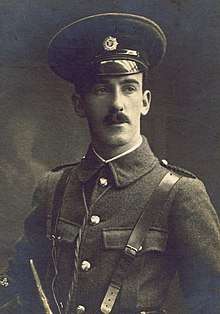Edward Daly (Irish revolutionary)
Edward "Ned" Daly (25 February 1891 – 4 May 1916) (Irish: Éamonn Ó Dálaigh); was commandant of Dublin's 1st battalion during the Easter Rising of 1916. He was the youngest man to hold that rank, and the youngest executed in the aftermath.
Edward Daly | |
|---|---|
 | |
| Born | 25 February 1891 Limerick, Ireland |
| Died | 4 May 1916 (aged 25) Kilmainham Gaol, Dublin, Ireland |
| Allegiance | Irish Volunteers Irish Republican Brotherhood |
| Years of service | 1913–1916 |
| Rank | Commandant |
| Commands held | 1st battalion |
| Battles/wars | Easter Rising |
Background
Born as John Edward Daly[1] at 26 Frederick Street (now O'Curry street), Limerick, Daly was the only son among the ten children born to Edward and Catherine Daly (née O'Mara). He was the younger brother of Kathleen Clarke, wife of Tom Clarke, and an active member of the Irish Republican Brotherhood (IRB). His father, Edward, was a Fenian (IRB member) who died five months before his son's birth at the age of forty-one.[2] His uncle was John Daly, a prominent republican who had taken part in the Fenian Rising and Fenian Dynamite Campaign. It was through John Daly that Clarke had met his future wife.[2]
He was educated by the Presentation Sisters at Sexton Street, the Congregation of Christian Brothers at Roxboro Road and at Leamy’s commercial college. He spent a short time as an apprentice baker in Glasgow, before returning to Limerick to work in Spaight's timber yard. He later moved to Dublin where he eventually took up a position with a wholesale chemists. In 1913 he moved to Dublin where he lived with Kathleen and Tom Clarke.[2][3]
Political Involvement
Although Daly's membership of the IRB is certain, it is not known when he joined the organisation. In November 1913 Daly joined the newly founded Irish Volunteers.[2] He soon reached the rank of captain. He was assiduous in his study of military manuals and the professionalism of his company gained the admiration of senior officers in actions such as the Howth gun-running of 1914.[2] In March 1915, he was promoted to the rank of commandant of the 1st Battalion.[2] Like many other of the rising's leaders Daly was a member of the Keating branch of the Gaelic League.[4]
The Easter Rising
Daly's battalion, stationed in the Four Courts and areas to the west and north of the centre of Dublin, saw the most harsh fighting of the rising. He was forced to surrender his battalion on 29 April by Patrick Pearse. He was executed by firing squad on 4 May 1916, at the age of 25.
The men in his battalion spoke of him as a good leader. This opinion was also shared by a British officer that Daly's battalion had captured.
Bray railway station was renamed Bray Daly railway station in his honour in 1966.
References
- Helen Litton. 16 Lives: Edward Daly. p. 20.
- "The Executed: Edward Daly" (PDF). The 1916 Rising. National Library of Ireland. Retrieved 8 April 2017.
- Helen Litton. 16 Lives: Edward Daly. p. 4.
- Helen Litton. 16 Lives: Edward Daly. p. 54.
- Litton, Helen, Edward Daly, Dublin: O'Brien Press, 2013